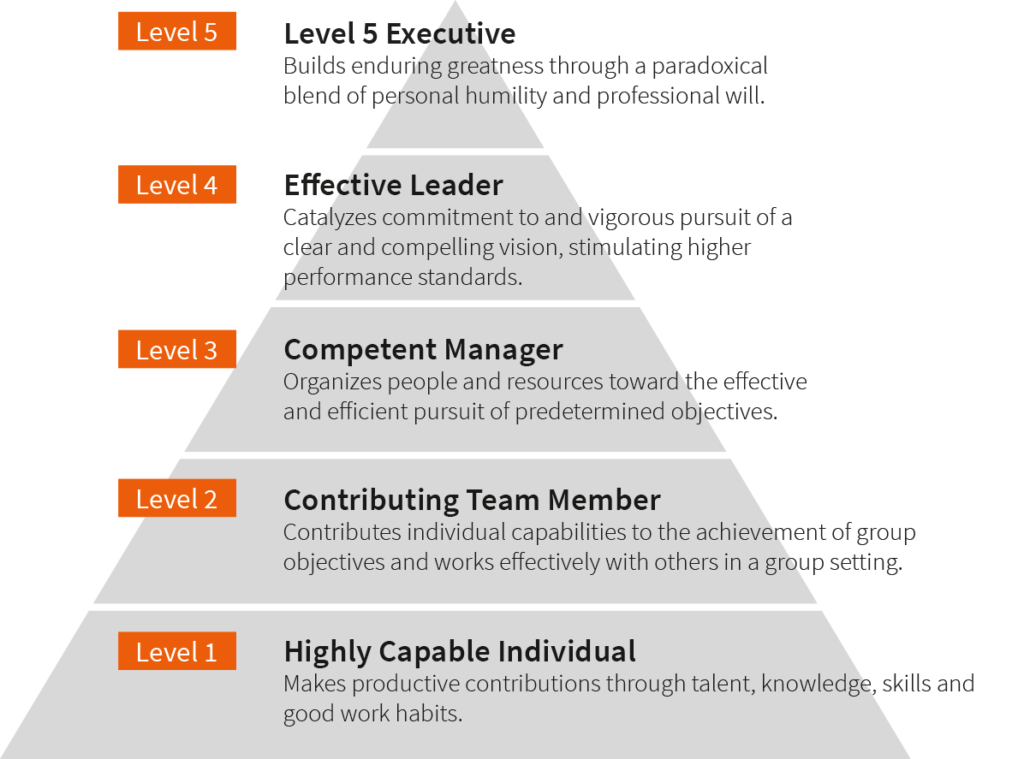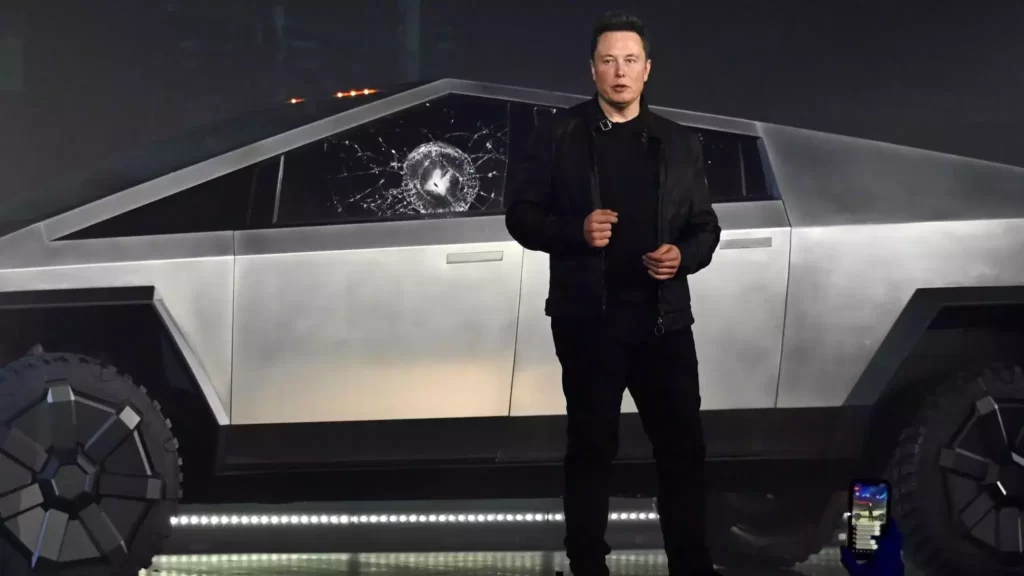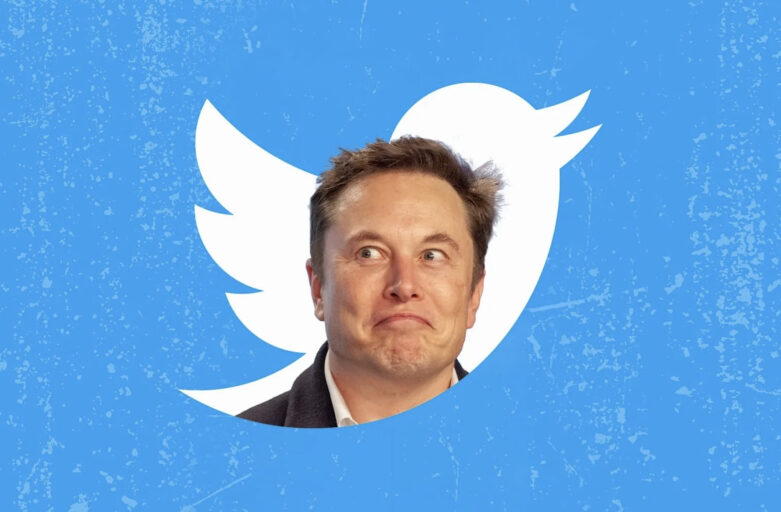First of all, we don’t drive a Tesla and are not Elon Musk fans. However, we do think that the recent developments since Elon Musk took over Twitter bring some interesting insights and learnings. Where multiple people coin Elon Musk as a poor leader, we tend to believe differently and share a different perspective. At the moment of writing this blog, Elon Musk just decided to step down as Twitter CEO as the result of his own “democratic” poll.
Since Musk walked into the Twitter office with a sink on 26 October 2022 to “let that sink in!” we’ve been following his posts on Twitter. To determine if Twitter, under the leadership of Musk, will even have an opportunity for success, we’ve analyzed his posts over the last months against Jim Collin’s Level 5 Leadership Hierarchy model[1].

Levels 1 to 4 are necessary for Leadership, but Level 5 makes the distinction between whether a company will just be “good” or will accel to become “great.” In our book “Leading in Digital Security,” we presented this model as a Leadership model that Digital Security Leaders can use for the development of their leadership skills. In this blog, we provide examples of Elon Musk and translate these examples into practical learnings for the current Leader in the Digital Security space, for example, directors of information security, chief information security officers, or other leadership roles dealing with digital.
Musks Level 5 Leadership Hierarchy model for Digital Security Leaders
In the following section, we will give our analysis per level and will end with our conclusion. We have put the relevant tweets as hyperlinks in the text (even without a Twitter account, you can read them, and the links don’t lead to phishing sites). This transparency allows you, as a reader, to form your own opinion and helps you to follow our reasoning.
Level 1 – Highly Capable Individual
Level 1 leaders make productive contributions through talent, knowledge, skills, and good working habits
In general, we can state that Musk must have extraordinary talent considering the success of companies like Tesla, SpaceX, Zip2, X.com and Paypal, Starlink, and Neuralink, being on the verge of becoming a success or one of failure. Even OpenAI (with ChatGPT) is a company he helped to establish.
At Twitter, the first focus seems to be on getting the basics in order. This resulted in increased performance and (partly) resolved the everlasting problem of the Bots, which now (end of 2022) seems to be significantly decreased. He also states that hate speech impressions are lower, whereas some, however, state the opposite (without supporting facts).
Musk also seems to be up to date with the technology used and involved in the development of the product. He knows what developments are in a release, is aware of the technical issues, knows where the technical improvements are, and knows how to make the product more efficient by turning off some microservices.
For Leaders in Digital Security, Level 1 doesn’t mean that you have to be a founder of four successful companies, but level 1 of Musk can teach us the following:
- Truly understand the problems and their root cause and solve them on a short notice
- Envision and understand where opportunities are
- Strive for simplicity; Change what is not working; remove what is not needed
- Have detailed insight into the roadmap. Not on the level of a “control” but on the release level of the different controls, e.g., what are the technical problems with the MFA implementation, and how many users are onboarded?
- Understand the technology that is used. You don’t need to be an expert but have the tenacity to scrutinize concepts. Be aware of your own “smart talk trap” and the IKEA effect, since you don’t have to try to be the best hacker because you don’t have time for that, and others are better at it.
- If you’re a more technical Digital Security Leader, understand politics, human behavior, the importance of processes and procedures, and changing people.
Level 2 – Contributing Team Member.
Level two leaders contribute their individual capabilities to the achievement of group objectives and work effectively with others in a group setting.
What stories about Tesla and SpaceX teach us about Musk is that he is definitely contributing to the team. At Twitter, it seems that he works hard together with the team and shows respect for the team working late. In the beginning, he ordered everyone to come work in the office or leave (same as with Tesla), and that even seemed to work. It seems that he is actively working with the team and not managing from a distance.
Next to that, Musk contributes as a leader by managing the external environment. He has been actively challenging the business model of Apple, and instead of leaving it up to others and lawyers to do the fight, he’s doing the talking himself with Apple CEO Tim Cook.
What we can learn from Musk about Level 2 is that, for example, as a CISO, you are also a member of the Team you are working with. This means that you need to spend time with your team and actively show your contribution so team members understand the value that you’re adding to the team.
Level 3 – Competent Manager
Level three leaders, on the other hand, have excellent management skills. They organize people and resources toward the effective and efficient pursuit of predetermined goals.
A competent manager hires and fires the right people for the job and allocates these people to the things that matter. When Musk arrived at Twitter, almost the first thing he did was fire the board. This is not, per definition, a role of a “Competent Manager,” but it is usually the right way to go if you want to change a company. Leaving current leadership in their position will make organizational change and change in culture more difficult. We sweep the stairs from top to bottom.
Next to that, Musk fired about 50% of the human resources on Twitter. To efficiently pursue the goals, he had to cut costs because Twitter was losing money. It was also mentioned and confirmed by Musk that Twitter itself was already planning to cut 25% of its staff to save costs.
Next to the staffing costs, he also quickly identified another money drain being, the food service, which was hardly used. Besides cutting costs, Musk also introduced new revenue streams with the $8 per month price tag for the blue mark. He also didn’t forget to pay attention to the existing revenue of the advertisers.
As many said that with 50% of staff fired, he also lost a lot of talent, he noted that World-class software aces are joining Twitter.
To summarize, we can state that Musk understands the importance of organizing the right people on the right priorities. He recognizes the balance between costs and revenue of the money resource very well.
Digital Security leaders could consider the following:
- Assigning people to the right priorities and not wasting resources on unimportant items.
- Fire the people that are not up to the job and especially don’t support the new vision or coming change in the organization. You don’t need “ducks” in your team.
- Nurture the existing money resources, work on tapping into new money resources, and definitely work on efficiently spending the money resources as well as cutting costs where possible (e.g., hardly used services, low-risk technology, and redundant functionality). In an earlier blog, we elaborate on the technology under- or misutilization and how we can “gain more bang for the buck.”
Level 4 – Effective Leader
Level four leaders are effective leaders. These leaders catalyze commitment to and pursuit of a clear and compelling vision. They are also great at stimulating higher performance standards.
Not long after Musk started, he also started communicating about the mission of Twitter, where he tweeted that this is the battle for the future of civilization, Twitter needs to become by far the most accurate source of information about the world, and all his efforts serve the Twitter purpose of free speech. With this Mission, he gives a higher purpose to what he wants to achieve with Twitter and is also setting high standards. With Tesla. He always envisioned a safer planet by getting rid of fossil fuels. With SolarCity, he had a similar vision.
After a month, Musk developed a new vision: the Twitter 2.0 everything app, in which Musk also communicated all the good things that had already happened since he arrived. In general, he has been tweeting a lot about the improvements made in Twitter, that it works better and has the highest usage ever.
To set high standards in working ethos, he is doing pretty much the same as in Tesla, which is his sleepovers on the office couch.
For the digital leader, this means
- Establishing and telling a compelling vision is crucial. In our previous blog, we describe how to develop one.
- Lead by example, and don’t be Phil Collins in the song “Jezus he knows me”……. “do as I say, not as I do.”
- Walk the talk, although the “smell of the place” might be bad or the culture is like, “this is how we do things around here.”
Level 5 – Executive.
Level five leaders build enduring greatness through a paradoxical blend of personal humility and professional will. These leaders can be the key to creating a great organization.
What we at least know about Elon Musk is that he has a huge professional will. His dedication to his companies is incredible. Since he walked into the Twitter Head office, it seems that he has never left the office, considering the number of tweets about the developments at Twitter. His “sleeping in the office” approach seems to be his unique drive for change.
Regarding humility, people might think that he has a lot of skills, but humility is not one of them. However, when you read his tweets, he seems to be humbler than you might think. He has no problem with making mistakes and telling people about them. Suppose you think about the Tesla Cybertruck presentation where the windows got damaged during the demo. He was open and honest about these setbacks.

Also, on Twitter, he tweeted that he hired people back that he fired and admitted that he was wrong. He also states that Twitter will do a lot of dumb things in the coming months. Next to that, he is actively seeking the Voice of the Customer and asks for screenshots of things that need a fix. The most recent one where he is very humble, or maybe making himself vulnerable, is the Poll where he asked everyone to vote on whether he should step down as a CEO or not. People voted for him to step down, and so he will do that.
It is sometimes hard to determine whether it is real humility what we’re seeing because he is also very determined in what he wants and has a very strong belief in what he can achieve. On the other hand, we also read he can be very dominant and harsh. However, it seems that he’s not interested in status or showing himself in the spotlights. He is just keen on achieving what he thinks is the right thing. Goal-oriented but also open to feedback and be able to be vulnerable.
For Digital Leaders, this underpins the importance of having a professional will and that achieving overall goals is more important than your personality. Meaning to accept losing your job to achieve what you believe is the right thing to do. In some companies where there is a lot of politics, you might need to choose between the goal and losing your integrity.
Achieving the goal is also more important than receiving personal credit for it, and it’s more important to see teams grow rather than yourself. Collins Leadership Hedgehog concept refers to the focus on goals and that “other people’s success is your happiness.”
Conclusion
Although some might think Elon Musk is a poor leader, his achievements demonstrate the opposite. There will always be lovers and haters, but as far as we observe, due to our observations, he doesn’t care about that. His main focus is achieving what he believes is the right thing to do, whether it is disrupting the automotive industry to save the planet, discovering orbit for future life, or improving the freedom of speech and the press.
For Digital Security leaders and CISOs in specific, the same applies. Next to being a great professional (level 1), a good team player (level 2), a strong manager (level 3), and a great leader (level 4), modesty and dedication to your vision are essential in achieving your goals. Level 5 leaders embody ambition for the success of his/her company. He/she wants his company to succeed, irrespective of his presence at the helm.
[1] ‘Jim Collins, Good to Great, why some companies take the leap and other don’t, 2001’ In this book Jim Collins examines the 5 levels of leadership characteristics based on longitudinal research in many multinationals.
